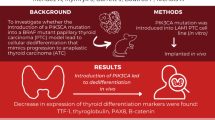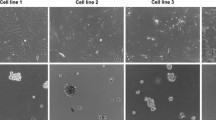Abstract
Papillary thyroid carcinoma (PTC) is the most frequent thyroid carcinoma. PTC cell lines have been of considerable value in studying aspects of thyroid cancer, such as gene expression, cell proliferation, and differentiation. Here we report three novel PTC lines established from three patients with different backgrounds. Case 1 was a 38-year-old woman with PTC in the right thyroid lobe, with no metastasis. The cell line was established from the resection sample and named D-PTC. The cell line consisted of epithelial cells with few lysosomes and showed a pavement structure and follicular formation at confluency. There was a little pilling up. The secretion of free thyroxin (fT4) and thyroglobulin (Tg) was increased by TSH, or GH and IGF-I treatment. Case 2 was a 22-year-old woman with PTC initially in the right thyroid lobe, but 4 years after the right lobe resection, PTC metastasis was observed in left lobe. The cell line was established from a sample of the second resection and named UD-PTC. This cell line consisted of small epithelial cells with evident lysosomes and exhibited floating cell clusters. The secretion of fT4 and Tg was slightly increased by TSH, or GH and IGF-I treatment. Case 3 was an 85-year-old man with PTC and with acromegaly. Metastasis was observed at cervical lymph nodes. The cell line was derived from the metastasis region and named A-PTC. This cell line consisted of small epithelial cells and many lysosomes. The cells frequently showed pilling up. The secretion of fT4 and Tg was significantly increased by GH and IGF-I treatment. We have established three PTC cell lines with substantial variation in their phenotype. The cell lines may be useful for thyroid cancer research.




Similar content being viewed by others
References
Glim O. Thyroid cancer. Cancer Lett. 2001;163:143–56.
Samaan NA, Schultz PN, Hickey RC, Goepfert H, Haynie TP, Johnston DA, Ordonez NG. The results of various modalities of treatment of well differentiated thyroid carcinomas: a retrospective review of 1599 patients. J Clin Endocrinol Metab. 1992;75:714–20.
Mazzaferri EL, Robbins RJ, Spencer CA, Braverman LE, Pacini F, Wartofsky L, Haugen BR, Sherman SI, Cooper DS, Braunstein GD, Lee S, Davies TF, Arafah BM, Ladenson PW, Pinchera A. A consensus report of the role of serum thyroglobulin as a monitoring method for low-risk patients with papillary thyroid carcinoma. J Clin Endocrinol Metab. 2003;88:1433–41.
Zielke A, Tezelman S, Jossart GH, Wong M, Siperstein AE, Duh QY, Clark OH. Establishment of a highly differentiated thyroid cancer cell line of Hürthle cell origin. Thyroid. 1998;8:475–83.
Ohta K, Pang XP, Berg L, Hershman JM. Growth inhibition of new human thyroid carcinoma cell lines by activation of adenylate cyclase through the beta-adrenergic receptor. J Clin Endocrinol Metab. 1997;82:2633–8.
Ohta K, Pang XP, Berg L, Hershman JM. Antitumor actions of cytokines on new human papillary thyroid carcinoma cell lines. J Clin Endocrinol Metab. 1996;81:2607–12.
Lin JD, Chao TC, Weng HF, Huang HS, Ho YS. Establishment of xenografts and cell lines from well-differentiated human thyroid carcinoma. J Surg Oncol. 1996;63:112–8.
Fabien N, Fusco A, Santoro M, Barbier Y, Dubois PM, Paulin C. Description of a human papillary thyroid carcinoma cell line. Morphologic study and expression of tumoral markers. Cancer. 1994;73:2206–12.
Grimm D, Hofstädter F, Bauer J, Spruss T, Steinbach P, Bernhardt G, Menze R. Establishment and characterization of a human papillary thyroid carcinoma cell line with oxyphilic differentiation (ONCO-DG 1). Virchows Arch B Cell Pathol Incl Mol Pathol. 1992;62(2):97–104.
Basolo F, Giannini R, Toniolo A, Casalone R, Nikiforova M, Pacini F, Elisei R, Miccoli P, Berti P, Faviana P, Fiore L, Monaco C, Pierantoni GM, Fedele M, Nikiforov YE, Santoro M, Fusco A. Establishment of a non-tumorigenic papillary thyroid cell line (FB-2) carrying the RET/PTC1 rearrangement. Int J Cancer. 2002;97:608–14.
Kurebayashi J, Tanaka K, Otsuki T, Moriya T, Kunisue H, Uno M, Sonoo H. All-trans-retinoic acid modulates expression levels of thyroglobulin and cytokines in a new human poorly differentiated papillary thyroid carcinoma cell line, KTC-1. J Clin Endocrinol Metab. 2000;85:2889–96.
Koh CS, Ku JL, Park SY, Kim KH, Choi JS, Kim IJ, Park JH, Oh SK, Chung JK, Lee JH, Kim WH, Kim CW, Cho BY, Park JG. Establishment and characterization of cell lines from three human thyroid carcinomas: responses to all-trans-retinoic acid and mutations in the BRAF gene. Mol Cell Endocrinol. 2007;264:118–27.
Melmed S. Medical progress: acromegaly. N Engl J Med. 2006;355:2558–73.
Choi W, Eum SY, Lee YW, Hennig B, Robertson LW, Toborek M. PCB 104-induced proinflammatory reactions in human vascular endothelial cells: relationship to cancer metastasis and atherogenesis. Toxicol Sci. 2003;75:47–56.
Tanaka K, Otsuki T, Sonoo H, Yamamoto Y, Udagawa K, Kunisue H, Arime I, Yamamoto S, Kurebayashi J, Shimozuma K. Semi-quantitative comparison of the differentiation markers and sodium iodide symporter messenger ribonucleic acids in papillary thyroid carcinomas using RT-PCR. Eur J Endocrinol. 2000;142:340–6.
Spandidos A, Wang X, Wang H, Seed B. PrimerBank: a resource of human and mouse PCR primer pairs for gene expression detection and quantification. Nucleic Acids Res. 2010;38:D792–3.
Hesse E, Musholt PB, Potter E, Petrich T, Wehmeier M, von Wasielewski R, Lichtinghagen R, Musholt TJ. Oncofoetal fibronectin—a tumour-specific marker in detecting minimal residual disease in differentiated thyroid carcinoma. Br J Cancer. 2005;93:565–70.
Wang X, Spandidos A, Wang H, Seed B (2012) PrimerBank: a PCR primer database for quantitive gene expression analysis. Nucl Acids Res 40:D1144–49
Akagi T, Luong QT, Gui D, Said J, Selektar J, Yung A, Bunce CM, Braunstein GD, Koeffler HP. Induction of sodium iodide symporter gene and molecular characterisation of HNF3 beta/FoxA2, TTF-1 and C/EBP beta in thyroid carcinoma cells. Br J Cancer. 2008;99:781–8.
Takahashi K, Tanabe K, Ohnuki M, Narita M, Ichisaka T, Tomoda K, Yamanaka S. Induction of pluripotent stem cells from adult human fibroblasts by defined factors. Cell. 2007;131:861–72.
Taura D, Noguchi M, Sone M, Hosoda K, Mori E, Okada Y, Takahashi K, Homma K, Oyamada N, Inuzuka M, Sonoyama T, Ebihara K, Tamura N, Itoh H, Suemori H, Nakatsuji N, Okano H, Yamanaka S, Nakao K. Adipogenic differentiation of human induced pluripotent stem cells: comparison with that of human embryonic stem cells. FEBS Lett. 2009;583:1029–33.
Wianny F, Bernat A, Huissoud C, Marcy G, Markossian S, Cortay V, Giroud P, Leviel V, Kennedy H, Savatier P, Dehay C. Derivation and cloning of a novel rhesus embryonic stem cell line stably expressing tau-green fluorescent protein. Stem Cells. 2008;26:1444–53.
Bidart JM, Lacroix L, Evain-Brion D, Caillou B, Lazar V, Frydman R, Bellet D, Filetti S, Schlumberger M. Expression of Na+/I− symporter and Pendred syndrome genes in trophoblast cells. J Clin Endocrinol Metab. 2000;85:4367–72.
Arturi F, Russo D, Bidart JM, Scarpelli D, Schlumberger M, Filetti S. Expression pattern of the pendrin and sodium/iodide symporter genes in human thyroid carcinoma cell lines and human thyroid tumors. Eur J Endocrinol. 2001;145:129–35.
Brabant G, Maenhaut C, Köhrle J, Scheumann G, Dralle H, Hoang-Vu C, Hesch RD, von zur Mühlen A, Vassart G, Dumont JE. Human thyrotropin receptor gene: expression in thyroid tumors and correlation to markers of thyroid differentiation and dedifferentiation. Mol Cell Endocrinol. 1991;82:R7–12.
Takano T, Amino N. Identifying thyroid carcinomas by cancer-specific mRNAs. Endocr J. 2000;47(Suppl):93.
Reya T, Morrison SJ, Clarke MF, Weissman IL. Stem cells, cancer, and cancer stem cells. Nature. 2001;414:105–11.
Takahashi K, Yamanaka S. Induction of pluripotent stem cells from mouse embryonic and adult fibroblast cultures by defined factors. Cell. 2006;25(126):663–76.
Masaki H, Ishikawa T, Takahashi S, Okumura M, Sakai N, Haga M, Kominami K, Migita H, McDonald F, Shimada F, Sakurada K. Heterogeneity of pluripotent marker gene expression in colonies generated in human iPS cell induction culture. Stem Cell Res. 2007;1:105–15.
Carina V, Zito G, Pizzolanti G, Richiusa P, Criscimanna A, Rodolico V, Tomasello L, Pitrone M, Arancio W, Giordano C. Multiple pluripotent stem cell markers in human anaplastic thyroid cancer: the putative upstream role of SOX2. Thyroid. 2013;23:829–37.
Antonica F, Kasprzyk DF, Opitz R, Iacovino M, Liao XH, Dumitrescu AM, Refetoff S, Peremans K, Manto M, Kyba M, Costagliola S. Generation of functional thyroid from embryonic stem cells. Nature. 2012;491:66–71.
Ma R, Latif R, Davies TF. Thyroid follicle formation and thyroglobulin expression in multipotent endodermal stem cells. Thyroid. 2013;23:385–91.
Tita P, Ambrosio MR, Scollo C, Carta A, Gangemi P, Bondanelli M, Vigneri R, degli Uberti EC, Pezzino V. High prevalence of differentiated thyroid carcinoma in acromegaly. Clin Endocrinol (Oxf). 2005;63:161–7.
Ruchala M, Skiba A, Gurgul E, Uruski P, Wasko R, Sowinski J. The occurrence of thyroid focal lesions and a need for fine needle aspiration biopsy in patients with acromegaly due to an increased risk of thyroid cancer. Neuro Endocrinol Lett. 2009;30:382–6.
Acknowledgments
The authors thank Dr. M. J. Waters (Institute for Molecular Biology, Univ. of Queensland, Qld, Australia) for his help during the preparation of this paper.
Author information
Authors and Affiliations
Corresponding author
Additional information
M. Ishikawa is formerly affiliated to Division of Diabetes, Metabolism and Endocrinology, Toho University School of Medicine, Tokyo, Japan
Rights and permissions
About this article
Cite this article
Ishikawa, M., Tachibana, T., Hashimoto, H. et al. Functional analysis of three novel cell lines derived from human papillary thyroid carcinomas with three different clinical courses. Human Cell 27, 111–120 (2014). https://doi.org/10.1007/s13577-014-0088-9
Received:
Accepted:
Published:
Issue Date:
DOI: https://doi.org/10.1007/s13577-014-0088-9




